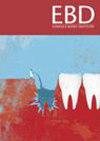Topical anesthetics methods used to reduce needle pain/discomfort prior to local anesthesia in children and adolescents: a scoping review
IF 2.3
Q3 Dentistry
引用次数: 0
Abstract
The aim of this study was to review the most effective topical anesthetic methods for reducing pain/discomfort prior to dental local anesthetic needle puncture for dental procedures in children and adolescents. A scoping review was conducted. Individual search strategies were developed for each of the bibliographic databases (Cochrane, Embase, LILACS, LIVIVO, Pubmed, Scopus, PsyINFO, Web of Science), and in the gray literature (Google Scholar, Open Gray), comprehensively, without restrictions on language, publication data, or level of socioeconomic development of the country in which the study was conducted. The search was conducted on April 21, 2021 and the updates on May 24, 2024. Randomized controlled studies conducted in patients up to 18 years of age were included. Variables collected: characteristics of the included studies, topical anesthetics evaluated, time and the mode of application. Initially, 8579 studies were retrieved. Then 3127 were identified as eligible, of which (n = 3127), 52 studies were included in the narrative synthesis. The most commonly observed anesthetic methods with the most favorable outcomes were lidocaine, benzocaine, ice cooling, and EMLA. Spray, gel or patch were used, with application times ranging from 1 to 10 min. Mucosal cooling an ice stick was analyzed by eight studies. Only one showed a smaller reduction in pain perception scores than others. Cooling is a technique with numerous clinical advantages from the clinical point of view, for reduction of pain/discomfort prior to needle puncture of dental local anesthesia in children and adolescents. It is an accessible, inexpensive and pleasant method that does not resemble needles or unpleasant tastes, nor involves systemic toxicity and complications that may be associated with others anesthetics agents. Future randomized controlled studies in accordance with the Consort Statement are needed to further investigate the topic.

用于减轻儿童和青少年局部麻醉前针刺疼痛/不适的局部麻醉方法:范围综述。
目的:本研究的目的是回顾最有效的表面麻醉方法,以减少儿童和青少年牙科手术中局部麻醉针穿刺前的疼痛/不适。方法:进行范围综述。针对每个书目数据库(Cochrane、Embase、LILACS、LIVIVO、Pubmed、Scopus、PsyINFO、Web of Science)和灰色文献(b谷歌Scholar、Open gray)制定了全面的个人搜索策略,不受语言、出版数据或研究所在国家社会经济发展水平的限制。搜索于2021年4月21日进行,更新于2024年5月24日进行。纳入了对18岁以下患者进行的随机对照研究。收集的变量:纳入研究的特征,评估的局部麻醉剂,时间和应用方式。结果:最初,8579项研究被检索到。然后确定3127项研究符合条件,其中(n = 3127) 52项研究纳入叙事综合。最常见的麻醉方法是利多卡因、苯佐卡因、冰冷却和EMLA。使用喷雾,凝胶或贴片,应用时间为1至10分钟。八项研究分析了冰棒的粘膜冷却作用。只有一个人在痛觉得分上的下降幅度小于其他人。结论:从临床角度来看,冷却是一种具有许多临床优势的技术,可以减少儿童和青少年牙科局部麻醉针刺前的疼痛/不适。这是一种方便、廉价和令人愉快的方法,不像针头或令人不快的味道,也不涉及可能与其他麻醉剂相关的全身毒性和并发症。未来需要根据Consort声明进行随机对照研究以进一步研究该主题。
本文章由计算机程序翻译,如有差异,请以英文原文为准。
求助全文
约1分钟内获得全文
求助全文
来源期刊

Evidence-based dentistry
Dentistry-Dentistry (all)
CiteScore
2.50
自引率
0.00%
发文量
77
期刊介绍:
Evidence-Based Dentistry delivers the best available evidence on the latest developments in oral health. We evaluate the evidence and provide guidance concerning the value of the author''s conclusions. We keep dentistry up to date with new approaches, exploring a wide range of the latest developments through an accessible expert commentary. Original papers and relevant publications are condensed into digestible summaries, drawing attention to the current methods and findings. We are a central resource for the most cutting edge and relevant issues concerning the evidence-based approach in dentistry today. Evidence-Based Dentistry is published by Springer Nature on behalf of the British Dental Association.
 求助内容:
求助内容: 应助结果提醒方式:
应助结果提醒方式:


